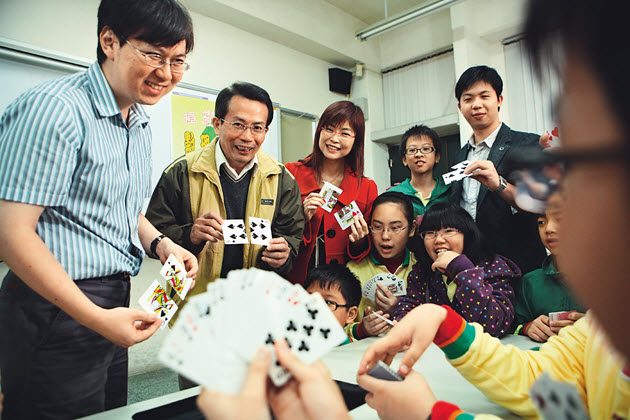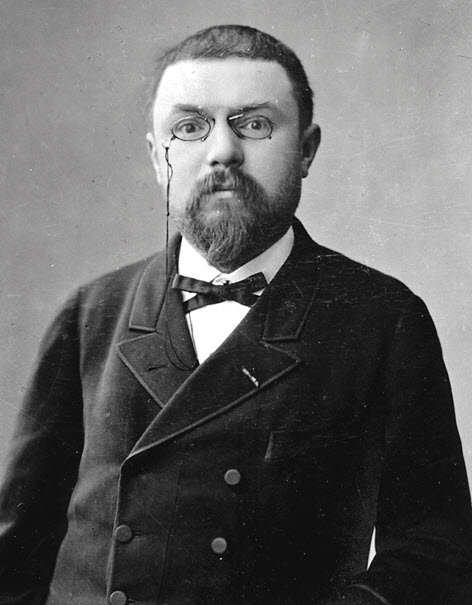Math Teachers Lin Shou-fu and Wu Ru-hao
'Mathemagic' Makes a New Hogwarts

Source:Domingo Chung
In Taipei's Xingya Junior High School, ten different waypoints conceal a total of 280 math problems, and its "Mathematics Corridor" sparkles with secret code. What is this wizardry that's giving math an allure worthy of Harry Potter?
Views
'Mathemagic' Makes a New Hogwarts
By Fuyuan HsiaoFrom CommonWealth Magazine (vol. 460 )
The autumn rays fall lazily downward at a nearly 90-degree angle, splashing across the gray and white patterned floor tiles. Three staff members hurriedly push a light-blue lunch trolley packed with lunchboxes down the third-floor Mathematics Corridor. Looking up, the spire of the 508-meter skyscraper Taipei 101 pierces the clouds. Down below, eighth-grade students clad in the light blue tracksuits that are the school's uniform kneel around math teacher Lin Shou-fu, intently searching among the floor tiles inlaid with geometric figures for the symbol of the Pythagorean Theorem.
Taiwan's First Math Corridor
Xingya Jr. High is located in the Xinyi Commercial District, Taipei's swankest real estate. The campus grounds are valued in the tens of billions of New Taiwan dollars. But the school's most precious asset – the first of its kind in a Taiwanese public school – is its Mathematics Corridor. The corridor has not only become a turning point in Lin Shou-fu's more than 20-year career as a math teacher, but has also inspired the mathematical imaginations of numerous young teenage minds.
Seven years ago the floor tiles of Xingya's classroom corridors were crumbling and in need of replacement. At the time Lin happened to be pondering ways to make the school's math curriculum more accessible, fun and intellectually stimulating, and he came up with a compelling idea: Why not design the floor to be embedded with mathematical code, using dozens of geometric shapes to emblazon the underlying principles of mathematics into the very floor tiles?
The further he took it, the more interesting it became. Lin and his fellow teachers began to cast a mathematician's eye toward revamping the whole school. From the electric sliding front gates, through the portico, on down to the school store, the activity center, the athletic field and swimming pool, they lay mathematical ambushes at ten different waypoints, concealing a total of 280 math problems, all relevant to the math curriculum the students will encounter during their three years of junior high: number sequences, geometry, triangles, functions, circumference, congruencies, and on and on...
"The shadow of mathematics falls everywhere in life," says Lin, a multiple award winner for outstanding teacher and for curriculum design. Lin says the most important thing in getting kids more interested in math is first getting them to let their psychological guard down. Once, on the first day of class, he asked his seventh graders their feelings about math. One-third raised their hands to say they hated it. From his experience in education, Lin knew that the first step toward getting students more interested in math was to make it more relevant, by illustrating the close connection between math and life.
For example, in a class on geometric shapes he extends his hand and asks the students to calculate how many of the windows in the apartment complex across the street are rectangular. In a lesson on number sequences, he instructs students to count the petals on the various flowers around campus, whereupon they find that a majority of their findings are relevant to the Fibonacci Sequence. He even arranges for students to make cameo appearances in his test questions. The school has a student suffering from microcephaly, and classmates assist the student in getting around in his wheelchair. In one math problem, Lin instructed students to calculate the total number of degrees in turns required to push the student's wheelchair from the front gate to the rest room. A photograph of the school also appeared in a Xingya math exam booklet, with the problem requiring students to use their protractors to calculate the distance between the school and Taipei 101 in answering the question: If the building were to topple over, would it hit the school?

Lin has also employed the various campus structures to devise a "labyrinth survival game" in which students explore the campus and determine by which routes the whole campus can be covered without backtracking. Consequently, students have, on behalf of the school principal, devised the shortest, most efficient routes by which the campus may be patrolled in its entirety, while at the same time learning the key relevant principle involved (there may be no more than two points where three paths intersect; more than two means the entirety cannot be covered in one stroke without backtracking).
Making Math More Alluring with Magic
Lin has not only adorned the school with mathematical code markings everywhere; he has also teamed up with young math teacher Wu Ru-hao in a "mathemagic" duo, performing for students all across Taiwan to promote math studies.
With only six years' experience teaching, Wu became profoundly aware of how difficult the current generation of teens is to teach, how tough it is to keep their attention in class. He found that if he simply lectured to them, they were "all bound to fall asleep." His students learned nothing, and ultimately had to go to the bushibans (cram schools) for extra tutoring. He began searching for a way to make math more intriguing for his students.
Magic has a sense of mystery, and so does math. Wu found that if he was going to make math more inspirational, the examples he gave would have to be representative, and major mathematical concepts would have to be able to be extended to different circumstances. Most crucially, a connection had to be made to the experiences of the students if studies were to be both broadly understandable and enjoyable. He began research into a variety of magic tricks involving mathematics.
A simple deck of playing cards can be used to perform thousands of number sequence tricks, to precisely determine the subject's surname, birth date, telephone number and "love code." Prior to beginning class, Wu routinely performs three to five minutes of magic, telling the assembled students that the coming weeks of math lessons will all be related to the tricks just performed, baiting the hook, enticing the students so they will have to pay attention in class if they want to learn the tricks. Once they have learned the mathematical magic, they need to come up with different applications in accordance with the theories. As the students invent different magic tricks, all kinds of creative ideas pop up. Arithmetical and geometrical ratios transmogrify into positive integers, negative integers, fractions... One trick morphs into a hundred different applications, and math is suddenly a hot topic among students.
"Math isn't about whether you understand, it's about whether you have a feeling. Students can feel the mathematical patterns around them. And even if they don't have a real talent for math, they can still become interested, can feel the utility, intrigue and power of mathematics," says Wu, whose refined, taciturn demeanor turns to passionate excitement when the subject turns to math.
Getting in the door through magic and sparking a sense of and an interest in math is one thing, but can the magic routine actually improve students' mathematical performance?
"Not necessarily," Wu says candidly. "It's just that the eyes of a kid who initially had no interest in math suddenly light up in class. They begin to jot down notes, chase you down after class to ask further questions, and it becomes evident that they haven't given up on math." It's exactly the effect he's looking for.
The "mathemagic" duo of Lin and Wu, separated in age by 22 years, is a big hit on campus, and they've also toured other schools and math/science summer camps and delivered countless speeches all over the island over the past two years, averaging over a hundred "performances" annually. They've also formed a "mathemagic" study circle with two other teachers, poring over popular science books and wracking their brains to develop new mathemagic routines. The ultimate objective is to elucidate the elements of mathematics better and more clearly, planting the seeds of love for math in students.
"Mathemagic is a ray of light at the door, shining and bright, beckoning you to come on in," Wu says, before adding bluntly: "But once you're in, there's a bumpy road of study ahead, and you have to take each step with patience." It won't magically improve performance or make the learning any easier. Actual mathematics still requires a lot of calculation, thinking, problem-solving and examinations – a rocky process no magic can replace. The magic is merely a brilliant flash at the start to reverse kids' anti-math biases, but it cannot replace real mathematics.
At the very least, these teachers with the magic touch are making math a lot easier to swallow.
Translated from the Chinese by Brian Kennedy






